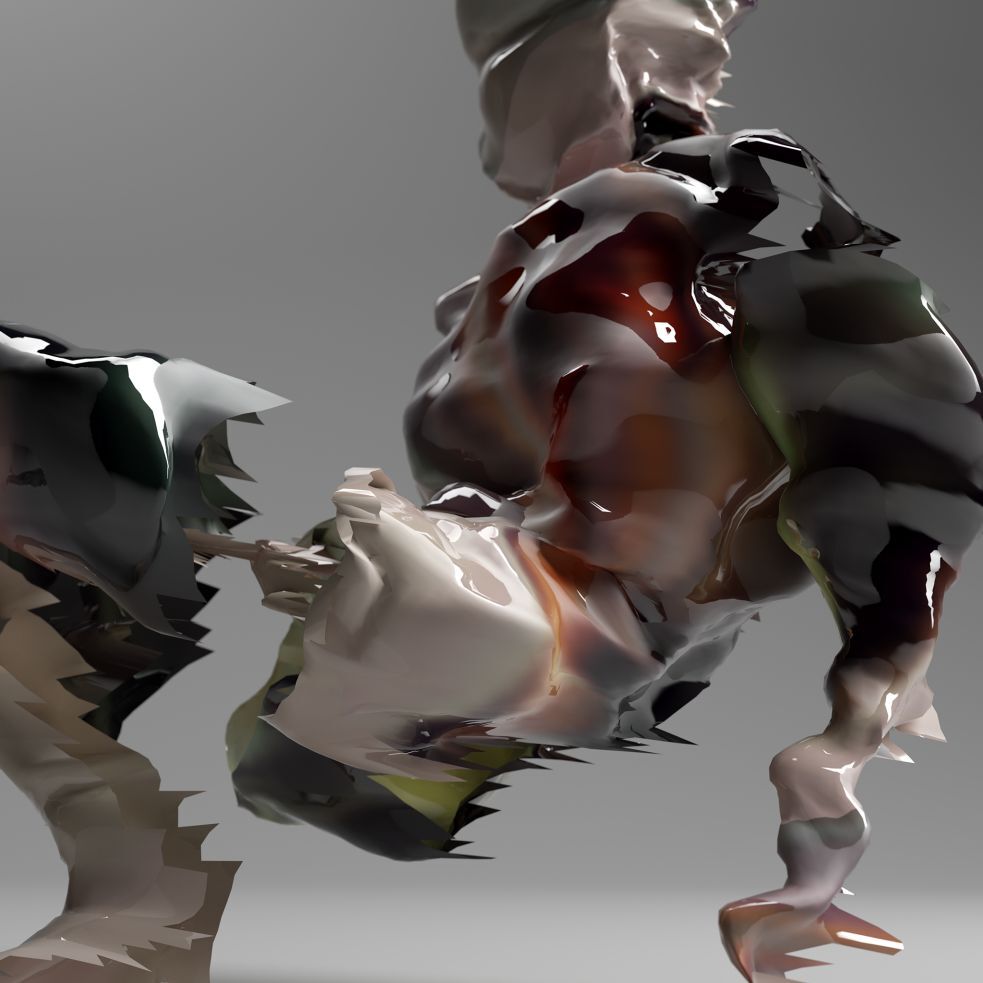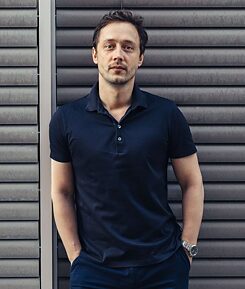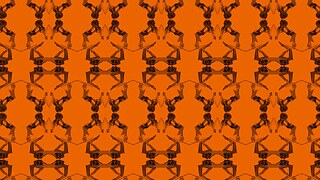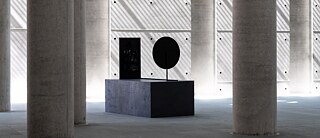“My material is mostly information”: AI artist Christian Mio Loclair in interview
Christian Mio Loclair is a Berlin-based new media artist who digitises human actions and humanises digital procedures. He spoke to the Goethe-Institut about the overlap between human movement and AI.
Christian Mio Loclair’s artistic work is heavily influenced by AI and data. The Berlin-based artist, who started out as a dancer himself, now uses technology to generate art and algorithms to build installations which continuously explore aesthetics and the friction of human identity.
His company, Waltz Binaire, designs and implements AI-based creative projects for the corporate sector as well as organisations. He spoke to the Goethe-Institut about his recent project Blackberry Winter and the way AI and machine learning influences his work.
You started out as a dancer who wanted to be robot. In recent times your interest has shifted towards developing generative artworks with increasingly human features and characteristics. Why not let humans be humans and robots be robots?
I think this overlapping space is what interests me most. I do believe that humans become increasingly mechanic and continuously reduce the complexity of their behaviour for the sake of speed and self-optimisation. On the other hand, we see machines that can heavily increase the complexity of their actions and appear even organic. It is as if we approach each other and our areas increasingly overlap. This proximity I think is a perfect melting pot to investigate what human behaviours have in common with mathematical procedures – and even more importantly – what we do not have in common. The things that cannot be reconstructed by digital algorithms might be the things that make us humans unique.
Please tell us about your work “Blackberry Winter.” What is the process behind it, and what do you wish to tell us with this artwork?
Blackberry Winter is part of a continuous research project of mine, in which I aim to create digital methods that are able to what I do: dance. As a human, I know I can dance and I know how it feels. In order to challenge this impression, I build digital procedures copying my behaviour, my knowledge and this particular feeling mentioned above. Throughout the last 15 years I have written little robot algorithms, choreography algorithms and even artificial judge robots determining the individual ability of humans to express themselves.
Blackberry Winter is my newest iteration of this series. This work is based on a data-driven solution. It is trained on 60,000 unsorted poses of bodies and tries to create its own human poses. In doing so I did not define the rules of dance for a computer myself: instead, I picked a huge amount of data and the algorithm taught itself. It is the closest I ever got to an autonomously moving, expressive body. I feel it resembles dance and yet it is like a completely empty shell. It has no intention and appears like a passive part of nature. I enjoy that thought since it challenges my perspective towards my initial thought: “I know I can dance and I know how it feels.” Maybe this part was just an illusion to begin with.
You have worked with Generative Adversarial Network (GAN) technology, in which two networks are placed into a game-like situation. The systems can be trained to create seemingly authentic art based on data of actually authentic art. Do you believe the work ‘authentic’ will shift in its meaning as these possibilities progress?
I do believe that the discussion of authenticity has been somewhat weaved into the arts over the past 100 years and that GAN technology is just an organic consequence of this movement. We continuously reiterate the necessity of human intervention and, therefore, ownership and authorship: The broken artefact of Duchamp’s Large Glass, the arts as a printable mass product, chance and randomness as a brush, the choreographies of Cunningham, and Instagram artists releasing two works per day for free.
GAN technology feels to me like an organic continuation of these trends. Does an artwork need inspiration, intention and the resulting artefact, or is an expression just a mathematical phenomenon of nature that can be created in the absence of any human desire? In my opinion, the question that arises through GAN is not whether machines have artistic talents – but the continuation of humans asking: are we artists?
 Blackberry Winter is a triptych of artificial human motion in asymmetry | © Christian Mio Loclair
In times of deepfakes, many people, media organisations and government bodies are increasingly concerned about malicious applications of the same types of technologies you use to create art. As an expert, do you have advice for regulatory bodies in how to deal with these problems?
Blackberry Winter is a triptych of artificial human motion in asymmetry | © Christian Mio Loclair
In times of deepfakes, many people, media organisations and government bodies are increasingly concerned about malicious applications of the same types of technologies you use to create art. As an expert, do you have advice for regulatory bodies in how to deal with these problems?
It is absolutely true that deepfake is based on a technique that is similar to what I use for the creation of my art. My perspective towards the current situation is split into two different views. From a technical standpoint I do not know how to solve it. Powerful networks generate artificial realities and other powerful networks detect if they appear real enough to fake humans. This interplay of artificial teacher and student systems is an incredible mighty tool and I think it is already not detectable anymore whether an image is generated by a camera capturing live footage or by an artificial intelligence. However, there are artists and activists using this technology for the sake of what I believe is good. And then there are other parties using this same technology to mislead people. The force that receives the most funding will probably determine the future of this technology.
You have stated that artists have a responsibility to reflect the culture the audience lives in, which includes technology. Are you implying that artists who do not use cutting-edge technology do not reflect culture, thereby saying that works from pre-digital times are outdated?
I think I was implying that artists have a responsibility to reflect the culture they live in, and not the traditions of the arts they work in. However, the artists that inspire me most have nothing to do with code or digital practice. I enjoy their relationship and perspective towards the environment they witness, no matter which tools they use.
In regards to my very own bubble and culture, I have been coding since I was a kid in 1992. I have witnessed the internet as an active programmer, studied computer science and have seen the rise of social media and machine learning. Code and digital practice were always natural to me as long as I can remember – it became my culture, my brush, my poetic interest. Trying to be a classical sculptor would feel to me like pretending to be a ninja running across roofs in urban scenarios. It just does not work for me.
While you usually work with human bodies and digital technologies, you have recently also started using marble for physical sculptures. What are the main challenges you are facing when you introduce new materials into your artistic process?
As a digital artist my material is mostly information. This information might be compressed into .jpg file as an image or an .obj file as a digital object or uploaded to a social media network – and then it might travel forever, without any weight to it. When working with real-world material I really enjoy how numbers translate into something that has a literal weight. It feels to me as if all the information I’m working with is just a part of a never-ending sentence and the material sometimes allows me to place a full-stop at the end.
Your works like Narciss and Blackberry Winter are not only interesting but also beautiful. Do you adjust the outcomes of the underlying processes in your concept-driven works in order to make them more presentable?
 Christian Mio Loclair | © Christian Mio Loclair
When documenting a work, I use different elements including code, video and audio to finish the work. Very often this documentation adds a layer to the actual work that is important to me. For example, Narciss itself is not beautiful at all in my opinion. It is a robot that thinks about itself. A computer with a camera in front of a mirror. Narciss remains rigid and cold. The video clip documenting Narciss, however, is the opposite. It is incredible excessive and overly dramatic. But this is not because I believe Narciss needs theatrical spaces and dramatic music to think about themselves. Instead, it is dramatic how theatrical we are when thinking about ourselves. And only about ourselves. Neither the work nor the clip is about robots.
Christian Mio Loclair | © Christian Mio Loclair
When documenting a work, I use different elements including code, video and audio to finish the work. Very often this documentation adds a layer to the actual work that is important to me. For example, Narciss itself is not beautiful at all in my opinion. It is a robot that thinks about itself. A computer with a camera in front of a mirror. Narciss remains rigid and cold. The video clip documenting Narciss, however, is the opposite. It is incredible excessive and overly dramatic. But this is not because I believe Narciss needs theatrical spaces and dramatic music to think about themselves. Instead, it is dramatic how theatrical we are when thinking about ourselves. And only about ourselves. Neither the work nor the clip is about robots.
With restrictions on movement all over the world, artists have increasingly shifted their focus to online projects. Nevertheless, people miss attending live performances, discussions and social interaction in general. Do you see areas in the arts that may change in the long term due to the pandemic?
Throughout the pandemic, I was incredibly proud to be part of a global scene of digital artists. Within this time I have seen the most spectacular and creative iterations popping up everywhere. A gigantic digital boost that moved forward and simply experimented. At my studio we are currently working day-and-night to develop the digital architecture for a digital museum. We have already created more than 40,000 square metres of exhibition space and we hope we can invite artists, curators and visitors to share their work soon.
The Future U exhibition at RMIT Gallery in Melbourne will present Christian’s Mio Loclair’s Blackberry Winter, a video installation showing artificial human motion in asymmetry.
Learn more about Christian Loclair's views on the future of creative AI here.
His company, Waltz Binaire, designs and implements AI-based creative projects for the corporate sector as well as organisations. He spoke to the Goethe-Institut about his recent project Blackberry Winter and the way AI and machine learning influences his work.
You started out as a dancer who wanted to be robot. In recent times your interest has shifted towards developing generative artworks with increasingly human features and characteristics. Why not let humans be humans and robots be robots?
I think this overlapping space is what interests me most. I do believe that humans become increasingly mechanic and continuously reduce the complexity of their behaviour for the sake of speed and self-optimisation. On the other hand, we see machines that can heavily increase the complexity of their actions and appear even organic. It is as if we approach each other and our areas increasingly overlap. This proximity I think is a perfect melting pot to investigate what human behaviours have in common with mathematical procedures – and even more importantly – what we do not have in common. The things that cannot be reconstructed by digital algorithms might be the things that make us humans unique.
Please tell us about your work “Blackberry Winter.” What is the process behind it, and what do you wish to tell us with this artwork?
Blackberry Winter is part of a continuous research project of mine, in which I aim to create digital methods that are able to what I do: dance. As a human, I know I can dance and I know how it feels. In order to challenge this impression, I build digital procedures copying my behaviour, my knowledge and this particular feeling mentioned above. Throughout the last 15 years I have written little robot algorithms, choreography algorithms and even artificial judge robots determining the individual ability of humans to express themselves.
Blackberry Winter is my newest iteration of this series. This work is based on a data-driven solution. It is trained on 60,000 unsorted poses of bodies and tries to create its own human poses. In doing so I did not define the rules of dance for a computer myself: instead, I picked a huge amount of data and the algorithm taught itself. It is the closest I ever got to an autonomously moving, expressive body. I feel it resembles dance and yet it is like a completely empty shell. It has no intention and appears like a passive part of nature. I enjoy that thought since it challenges my perspective towards my initial thought: “I know I can dance and I know how it feels.” Maybe this part was just an illusion to begin with.
You have worked with Generative Adversarial Network (GAN) technology, in which two networks are placed into a game-like situation. The systems can be trained to create seemingly authentic art based on data of actually authentic art. Do you believe the work ‘authentic’ will shift in its meaning as these possibilities progress?
I do believe that the discussion of authenticity has been somewhat weaved into the arts over the past 100 years and that GAN technology is just an organic consequence of this movement. We continuously reiterate the necessity of human intervention and, therefore, ownership and authorship: The broken artefact of Duchamp’s Large Glass, the arts as a printable mass product, chance and randomness as a brush, the choreographies of Cunningham, and Instagram artists releasing two works per day for free.
GAN technology feels to me like an organic continuation of these trends. Does an artwork need inspiration, intention and the resulting artefact, or is an expression just a mathematical phenomenon of nature that can be created in the absence of any human desire? In my opinion, the question that arises through GAN is not whether machines have artistic talents – but the continuation of humans asking: are we artists?
 Blackberry Winter is a triptych of artificial human motion in asymmetry | © Christian Mio Loclair
In times of deepfakes, many people, media organisations and government bodies are increasingly concerned about malicious applications of the same types of technologies you use to create art. As an expert, do you have advice for regulatory bodies in how to deal with these problems?
Blackberry Winter is a triptych of artificial human motion in asymmetry | © Christian Mio Loclair
In times of deepfakes, many people, media organisations and government bodies are increasingly concerned about malicious applications of the same types of technologies you use to create art. As an expert, do you have advice for regulatory bodies in how to deal with these problems?It is absolutely true that deepfake is based on a technique that is similar to what I use for the creation of my art. My perspective towards the current situation is split into two different views. From a technical standpoint I do not know how to solve it. Powerful networks generate artificial realities and other powerful networks detect if they appear real enough to fake humans. This interplay of artificial teacher and student systems is an incredible mighty tool and I think it is already not detectable anymore whether an image is generated by a camera capturing live footage or by an artificial intelligence. However, there are artists and activists using this technology for the sake of what I believe is good. And then there are other parties using this same technology to mislead people. The force that receives the most funding will probably determine the future of this technology.
You have stated that artists have a responsibility to reflect the culture the audience lives in, which includes technology. Are you implying that artists who do not use cutting-edge technology do not reflect culture, thereby saying that works from pre-digital times are outdated?
I think I was implying that artists have a responsibility to reflect the culture they live in, and not the traditions of the arts they work in. However, the artists that inspire me most have nothing to do with code or digital practice. I enjoy their relationship and perspective towards the environment they witness, no matter which tools they use.
In regards to my very own bubble and culture, I have been coding since I was a kid in 1992. I have witnessed the internet as an active programmer, studied computer science and have seen the rise of social media and machine learning. Code and digital practice were always natural to me as long as I can remember – it became my culture, my brush, my poetic interest. Trying to be a classical sculptor would feel to me like pretending to be a ninja running across roofs in urban scenarios. It just does not work for me.
While you usually work with human bodies and digital technologies, you have recently also started using marble for physical sculptures. What are the main challenges you are facing when you introduce new materials into your artistic process?
As a digital artist my material is mostly information. This information might be compressed into .jpg file as an image or an .obj file as a digital object or uploaded to a social media network – and then it might travel forever, without any weight to it. When working with real-world material I really enjoy how numbers translate into something that has a literal weight. It feels to me as if all the information I’m working with is just a part of a never-ending sentence and the material sometimes allows me to place a full-stop at the end.
Your works like Narciss and Blackberry Winter are not only interesting but also beautiful. Do you adjust the outcomes of the underlying processes in your concept-driven works in order to make them more presentable?
 Christian Mio Loclair | © Christian Mio Loclair
When documenting a work, I use different elements including code, video and audio to finish the work. Very often this documentation adds a layer to the actual work that is important to me. For example, Narciss itself is not beautiful at all in my opinion. It is a robot that thinks about itself. A computer with a camera in front of a mirror. Narciss remains rigid and cold. The video clip documenting Narciss, however, is the opposite. It is incredible excessive and overly dramatic. But this is not because I believe Narciss needs theatrical spaces and dramatic music to think about themselves. Instead, it is dramatic how theatrical we are when thinking about ourselves. And only about ourselves. Neither the work nor the clip is about robots.
Christian Mio Loclair | © Christian Mio Loclair
When documenting a work, I use different elements including code, video and audio to finish the work. Very often this documentation adds a layer to the actual work that is important to me. For example, Narciss itself is not beautiful at all in my opinion. It is a robot that thinks about itself. A computer with a camera in front of a mirror. Narciss remains rigid and cold. The video clip documenting Narciss, however, is the opposite. It is incredible excessive and overly dramatic. But this is not because I believe Narciss needs theatrical spaces and dramatic music to think about themselves. Instead, it is dramatic how theatrical we are when thinking about ourselves. And only about ourselves. Neither the work nor the clip is about robots.With restrictions on movement all over the world, artists have increasingly shifted their focus to online projects. Nevertheless, people miss attending live performances, discussions and social interaction in general. Do you see areas in the arts that may change in the long term due to the pandemic?
Throughout the pandemic, I was incredibly proud to be part of a global scene of digital artists. Within this time I have seen the most spectacular and creative iterations popping up everywhere. A gigantic digital boost that moved forward and simply experimented. At my studio we are currently working day-and-night to develop the digital architecture for a digital museum. We have already created more than 40,000 square metres of exhibition space and we hope we can invite artists, curators and visitors to share their work soon.
The Future U exhibition at RMIT Gallery in Melbourne will present Christian’s Mio Loclair’s Blackberry Winter, a video installation showing artificial human motion in asymmetry.
Learn more about Christian Loclair's views on the future of creative AI here.

